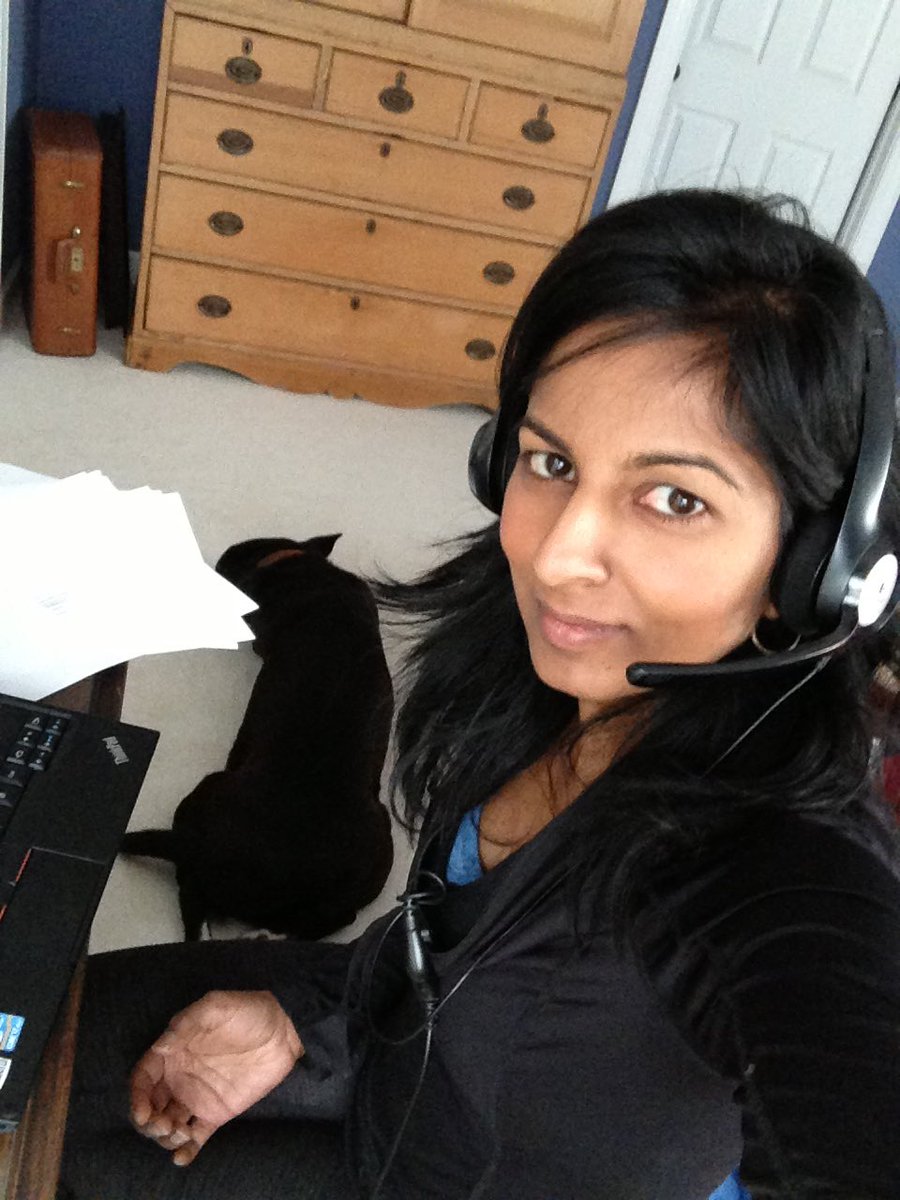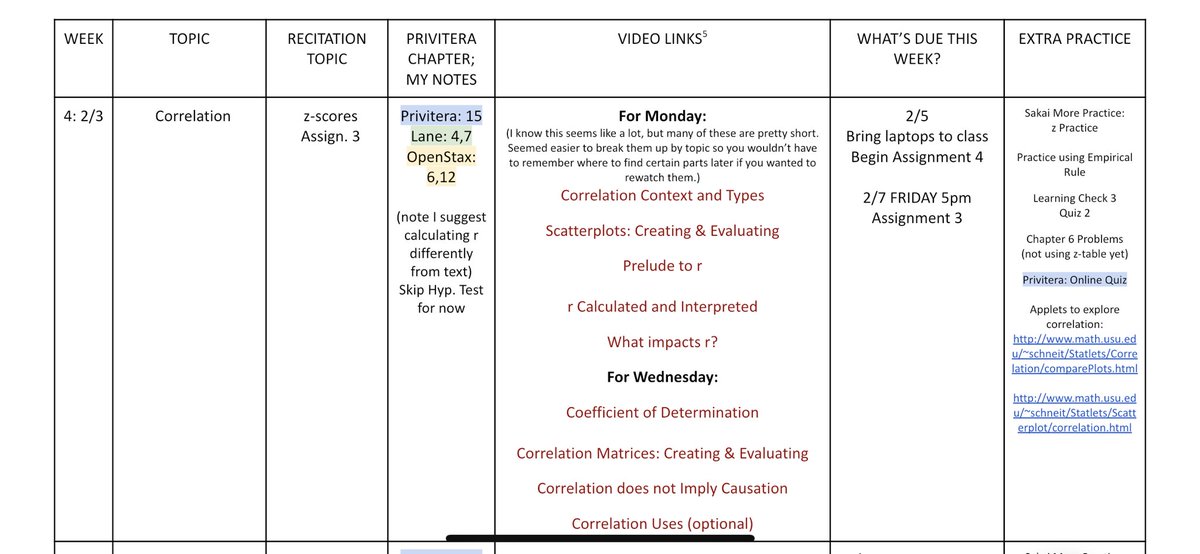Working on lecture capture? Here are tips & tricks to make it go smoother. About 10 yrs ago, I started lecture capturing to flip my #introstats course & it was enough to be notes/slides/software/laptop/audio/kids&dogs relatively quiet ready — I didn’t bother w/camera ready.
Deciding NOT to appear on video & focus on audio made the task simpler. No need to fuss w/makeup/hair, or see myself on screen during recording/editing. I know, I know, I shouldn’t have cared—but I did & do. Appearances for better or worse, matter; taking it off the table helped.
In retrospect this was a helpful move, b/c my voice ages less than my appearance. In nearly 10 yrs, I haven’t gone back to edit a single video. Not only did it save me time not being camera-ready, I didn’t have to fidget w/lighting or resolution, etc. The videos don’t feel dated.
You’re likely thinking: but that sounds boring and difficult to watch. It would be if I was narrating static images/slides. Instead I animated the slides in as I spoke (like class) & annotated calculations using a stylus. Example video: https://youtu.be/14eOLt0WOpg ">https://youtu.be/14eOLt0WO...
As an aside: this is called a “worked example” — a step-by-step demonstration of how to perform a task or how to solve a problem" (Clark, Nguyen, Sweller, 2006, p. 190). It’s extremely effective for initial skill acquisition. https://en.wikipedia.org/wiki/Worked-example_effect">https://en.wikipedia.org/wiki/Work...
Students want & need interaction for effective videos. The in-person cues & accountability are absent, but you don’t have to be visually present to provide that interaction. Annotating & embedding questions for students to respond to are very helpful ways to support engagement.
Some literature supports this idea: “learning from video lectures is enhanced by specific instructor presence features, such as instructor dynamic drawing & instructor eye contact,rather than by merely having the instructor visible on the screen” https://psycnet.apa.org/record/2018-58542-001">https://psycnet.apa.org/record/20...
I used @Camtasia to embed pre- and post- video questions into my videos — there are lots of recording tools that have this kind of feature. Students LOVE this type of engagement & it helps the learning stick (frequent formative feedback). FYI My embedded video q’s are ungraded.
Ok, next hack: keep your videos short!!! I cannot stress this enough. Think 3-5 minutes short. Editing, compiling, uploading, etc. all go smoother with short videos.
Bonus 1 for short videos: did you screw up or is it something that will likely need updating as knowledge/techniques evolve? Sitting down to record 2-3 mins is not a massive hurdle.
Bonus 2 for short videos: ever see a video posted online & notice the length? Be honest, what your reaction to a 20+ min. video?  https://abs.twimg.com/emoji/v2/... draggable="false" alt="🙄" title="Gesicht mit rollenden Augen" aria-label="Emoji: Gesicht mit rollenden Augen"> It’s an investment to carve up that time. Modularity makes consuming the info feel like less of a mental hurdle.
https://abs.twimg.com/emoji/v2/... draggable="false" alt="🙄" title="Gesicht mit rollenden Augen" aria-label="Emoji: Gesicht mit rollenden Augen"> It’s an investment to carve up that time. Modularity makes consuming the info feel like less of a mental hurdle.
Bonus 3 for short videos: Organization!!! As an expert you have a highly organized mental map of the material. You easily see the whole forest. A novice can easily see the trees but not the forest. Modularity via videos helps provide structure for your course content.
Bonus 4 for short videos: going back to review a concept is SO much easier when there are several small videos than when there is one long one. Think back to when you wanted to replay a specific part in a long video, what are your cues as to where to point it on the timeline?  https://abs.twimg.com/emoji/v2/... draggable="false" alt="🥴" title="Woozy face" aria-label="Emoji: Woozy face">
https://abs.twimg.com/emoji/v2/... draggable="false" alt="🥴" title="Woozy face" aria-label="Emoji: Woozy face">
In short, short videos are about efficiency for you, easy navigation & organization for the student, and translate to an overall doable mentality for all of us.
Another hack: make a mistake while recording? That’s ok!! Keep the “tape rolling” & just stop talking for about 5-10 seconds & start up again. The silence will be easy to spot in editing—cutting it out is much faster than stopping/resuming recording & patching videos together.
The stop talking hack saved me hours (literally) in production time. Sometimes I had multiple of these in one short recording. Cutting is easy-peasey. The cognitive load of restarting is heavy.
Another hack: Be personable. It’s ok to leave the occasion “um” or “well, that example was corny, sorry about that!” Or whatever it is that makes you, you in these videos. Students want to learn from a human being. Don’t aim for perfection, aim for conversation.
Honestly one of the hardest things for me was imagining a classroom as I’m speaking instead of staring into a screen. If it helps, print out a photo of a classroom around your monitor. Imagine talking to humans & not your screen, b/c eventually that’s who’ll hear you.
Do NOT underestimate the prep work needed to record. I’m not talking about content/slides (you likely have that & just need time to think about breaking it up into modules) but rather the mental energy to hole up & teach to your computer screen. This is a diff kind of prep work.
Those of us who teach in brick and mortar buildings feed off the verbal & nonverbal cues our students provide. Talking to a computer screen takes practice. If you have a ritual to get ready to teach, create a ritual to get ready to lecture capture.
Most of us are new to this task. Most of us are perfectionists. Most of us have seen nice highly-produced educational videos. You alone cannot make these—aim instead for connecting w/your students via these videos. Tell your relevant anecdotes, provide your lens, be you recorded.
I’ve learned that students LOVE these videos. When’s the last time you read a recipe just once & executed perfectly? My students re-watch videos, they pause, they take notes (I provide an outline for #inclusiveteaching). By recording, you’re investing in a tool that you’ll reuse.
I’ve had students with learning differences talk to me about the benefits of lecture capture. Students who went on to grad school/jobs re-watching these same “old” videos. You’re investing in their future learning too.
There’s one more thing I find curious & lovely about lecture capture. There’s a connection in putting on your headphones & hearing your instructor talk to you in your home, while you’re en route to work/school, etc. I’m w/them in their spaces at the time that is optimal for them.
Ever listen to a podcast or a book & feel like the person is speaking directly to you? The ability to do that via lecture capture is remarkable. There’s an intimacy in it that I’ve been in awe of. Yes, tech can be cold & uncaring; teaching is the opposite.
I have a ch. out in a forthcoming book on teaching statistics on the learning gains, the increased engagement, interest, closed gaps for women & POC. In short, redesigning my course brought equity front & center. I got to teach aligned w/my values. Tech allowed that to happen.
It can feel daunting to think about lecture capture, but it’s a hill worth climbing. We’ve all been dealt this horrible hand w/COVID (& the burden is disproportionately harder on some)—we can’t control much, but we can aim to control our course. We can build tools that will last.
Bonus track: you never have to bore yourself again with that mundane (but necessary) topic. Record, post, voila! You might even forget how much you disliked it. Now you have time to talk about the stuff you like, that gives you energy, that makes you love what you do.
Bonus track 2: you don’t need to do this alone. Consult your teaching center. Talk to colleagues who’ve done this. Here’s a free resource by @ACUE_HQ (I’m in the recording effective microlecture unit). https://acue.org/online-teaching-toolkit/">https://acue.org/online-te...
Bonus track 3: I appear alongside @mwesch. He’s phenomenal & is posting really great videos for making videos on his YouTube channel. https://www.youtube.com/c/mwesch ">https://www.youtube.com/c/mwesch&...
Bonus track 4: @karenraycosta has an amazing book on making videos. See if your campus teaching center or library has a copy or get your own to mark up. https://styluspub.presswarehouse.com/browse/book/9781642670851/99-Tips-for-Creating-Simple-and-Sustainable-Educational-Videos">https://styluspub.presswarehouse.com/browse/bo...
Bonus track 5: not specific to lecture capture per se, but #onlineteaching. You cannot go wrong reading/listening to anything by @Flowerdarby. I could cite many sources (including the @ACUE_HQ toolkit). This piece is one that I keep revisiting: https://www.chronicle.com/interactives/advice-online-teaching">https://www.chronicle.com/interacti...
From this piece @DrMrsKellyHogan & I wrote: “Besides teaching content & skills in your discipline, your role is to help students learn. And not just some students.” Being thoughtful in your approach to lecture capture is part of helping all students learn. https://www.chronicle.com/interactives/20190719_inclusive_teaching">https://www.chronicle.com/interacti...

 Read on Twitter
Read on Twitter




